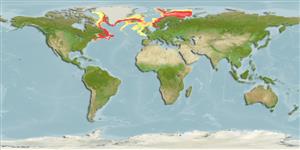Elasmobranchii (Haie und Rochen) (sharks and rays) >
Rajiformes (Skates and rays) >
Arhynchobatidae (Softnose skates)
Etymology: Bathyraja: Greek, bathys = deep + Latin, raja, -ae = a ray (Raja sp) (Ref. 45335).
Environment: milieu / climate zone / depth range / distribution range
Ökologie
seewasser bathypelagisch; tiefenbereich 111 - 2949 m (Ref. 117245), usually 165 - 255 m (Ref. 7251). Boreal; 2°C - 8°C (Ref. 117245); 80°N - 42°N, 80°W - 50°E
North Atlantic and adjacent Arctic.
Size / Gewicht / Alter
Maturity: Lm ? range ? - ? cm
Max length : 170 cm TL Männchen/unbestimmt; (Ref. 3167)
Kurzbeschreibung
Morphologie | Morphometrie
Disk without spines, except near edge of pectoral fins in males. Ventral mucous pores not blackish. Tail with middorsal row of large spines. Snout pointed (Ref. 7251). Upper surface pale brown or bluish gray without dark markings. Lower surface white with small sooty blotches irregularly distributed around margins of pectorals, pelvic fins white below. Lower surface of tail white but pale brown rearward (Ref. 6902).
An inhabitant of deep, cold water (Ref. 7251). Benthic (Ref. 58426). Feed on all kinds of bottom animals (Ref. 3167). Oviparous (Ref. 50449). Distinct pairing with embrace. Young may tend to follow large objects, such as their mother (Ref. 205). Eggs are oblong capsules with stiff pointed horns at the corners deposited in sandy or muddy flats (Ref. 205). Egg capsules are 13.4-16.5 cm long and 8.0-10.2 cm wide (Ref. 41251, 41301). This species is part of the regular by-catch of deep-sea fisheries (Ref. 117245).
Life cycle and mating behavior
Geschlechtsreife | Fortpflanzung | Ablaichen | Eier | Fecundity | Larven
Oviparous (Ref. 3167). Paired eggs are laid. Embryos feed solely on yolk (Ref. 50449). Distinct pairing with embrace. Young may tend to follow large objects, such as their mother (Ref. 205).
McEachran, J.D. and K.A. Dunn, 1998. Phylogenetic analysis of skates, a morphologically conservative clade of elasmobranchs (Chondrichthyes: Rajidae). Copeia 1998(2):271-290. (Ref. 27314)
IUCN Rote Liste Status (Ref. 130435)
Bedrohung für Menschen
Harmless
Nutzung durch Menschen
Fischereien: nicht kommerziell
Mehr Information
ReferenzenAquakulturAquakultur ProfilZuchtlinienGenetikElectrophoresesVererbbarkeitKrankheitenVerarbeitungNutrientsMass conversion
Tools
Zusatzinformationen
Download XML
Internet Quellen
Estimates based on models
Preferred temperature (Ref.
123201): 0.3 - 7.6, mean 2.5 °C (based on 411 cells).
Phylogenetic diversity index (Ref.
82804): PD
50 = 0.5000 [Uniqueness, from 0.5 = low to 2.0 = high].
Bayesian length-weight: a=0.00513 (0.00253 - 0.01042), b=3.12 (2.95 - 3.29), in cm total length, based on LWR estimates for this Genus-body shape (Ref.
93245).
Trophic level (Ref.
69278): 4.4 ±0.6 se; based on diet studies.
Widerstandsfähigkeit (Ref.
120179): niedrig, Verdopplung der Population dauert 4,5 - 14 Jahre. (Fec assumed to be <100).
Fishing Vulnerability (Ref.
59153): Very high vulnerability (90 of 100).
